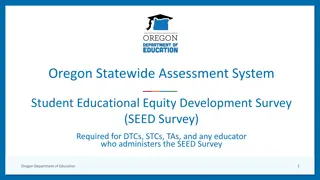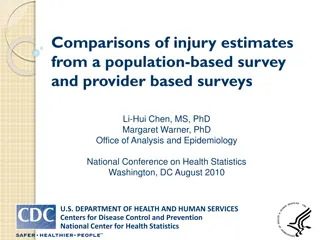Generalizing Research on Older Adults in Seattle Integrated Health System
This research project led by Laura Gibbons focuses on generalizing findings from the Adult Changes in Thought (ACT) study in a Seattle integrated health delivery system to all older adults in the region. By comparing ACT participants with the current Seattle area population and using survey weights
1 views • 29 slides
Tower Hamlets Annual Resident Survey 2023 Results Overview
The Tower Hamlets Annual Resident Survey 2023 provides insights into residents' feedback and opinions on various aspects. Conducted by MEL Research, the survey aims to capture a representative sample of residents in Tower Hamlets, highlighting statistical significance and methodology details. The su
1 views • 32 slides
Understanding Weighting Strategies for Disaggregated Racial-Ethnic Data
Delve into the importance of weighting strategies for disaggregated racial-ethnic data in health policy research. Learn about the purpose of weighting, considerations, and when weights are unnecessary. Discover how survey weights ensure the representativeness and generalizability of data to target p
3 views • 56 slides
Instructions for Completing GLAAS Country Survey 2024
In Module 4 of GLAAS information, you will find guidance on filling out the country survey for GLAAS 2024. Topics covered include an overview of the survey package, instructions for completing the survey either as a PDF or online (eGLAAS), general tips for successful completion, advice on governance
4 views • 42 slides
Dialysis Center Practices Survey Update for 2023
The National Center for Emerging and Zoonotic Infectious Diseases has announced changes to the Outpatient Dialysis Center Practices Survey and the Home Dialysis Center Practices Survey for 2023. The updated surveys include a new layout, clarified questions, and modifications to various sections. Fac
0 views • 20 slides
Understanding Gage Weights and Precipitation Methods in Hydrologic Modeling
Exploring the concept of gage weights and precipitation methods in hydrologic modeling using the HEC-HMS software. Dive into the pros and cons of flexible gage weighting, calibration processes, and best practices for estimating time and depth weights. Discover how to set up a gage weights model, inc
0 views • 11 slides
Understanding Perceptron Learning Algorithm in Neural Networks
Perceptron is the first neural network learning model introduced in the 1960s by Frank Rosenblatt. It follows a simple and limited (single-layer model) approach but shares basic concepts with multi-layer models. Perceptron is still used in some current applications, especially in large business prob
2 views • 54 slides
Historical Weights and Cost of Capital Analysis
The content discusses historical weights using market value weights for different securities like mortgage bonds, preferred stock, and common stock. It also delves into determining the overall cost of capital based on market value weights, including debt, preferred stock, common stock, and retained
0 views • 36 slides
Understanding Inverse Probability Weights in Epidemiological Analyses
In epidemiological analyses, inverse probability weights play a crucial role in addressing issues such as sampling, confounding, missingness, and censoring. By reshaping the data through up-weighting or down-weighting observations based on probabilities, biases can be mitigated effectively. Differen
0 views • 25 slides
Exploring Weight Measurement in Mathematics for Class III
This presentation delves into the concept of weight in mathematics for Class III students. It covers topics like identifying objects by weight, comparing weights, understanding units of weight, conversions, addition and subtraction of weights, and practical applications of weight in daily life and p
0 views • 35 slides
University Partnership Forum 2018: Survey Results & Feedback Analysis
The UK's European University Partnership Forum 2018 presents survey findings from the Partner Institution Survey 2016/17 conducted by Matthew Redmond. The survey aims to gather direct feedback from partner students on teaching, assessment, support, resources, and personal development. It highlights
0 views • 18 slides
Overview of Non-Point Survey Training and Updates
This content provides detailed information and resources related to the Non-Point Survey Training Program, including modules, topics covered, process flow for completing the survey, reasons for conducting the survey, and changes made in the survey since the 2014 inventory. It also addresses common i
1 views • 13 slides
Understanding the VLA Sky Survey and Its Scientific Goals
The VLA Sky Survey (VLASS) is a comprehensive radio survey covering the sky visible to the VLA, conducted in three epochs with a focus on imaging galaxies, detecting transient events, exploring Faraday tomography, and uncovering hidden phenomena in the universe. The survey employs innovative strateg
1 views • 22 slides
Best Sash Weights Manufacturer in Epping Upland
Are you looking for the Best Sash Weights Manufacturer in Epping Upland? Then contact Trade Sash Weights Ltd. They produce an extensive range of sizes of Sash Lead Weights to be used in traditional box sash windows. They currently supply Lead Sash We
0 views • 6 slides
Understanding Cosine Similarity in Inverted Index for Querying
In this document, Dr. Claudia Pearce explains how to build and query from an inverted index, focusing on calculating the Cosine Similarity. The process involves calculating the dot product of terms in the document and query, updating sums based on term weights, and understanding the significance of
0 views • 15 slides
Understanding the ACGME Resident Survey: Insights and Guidelines
The ACGME Resident Survey is conducted annually to gather confidential data on residents' clinical and educational experiences. The survey aids in program accreditation and identifies areas for improvement. Answer honestly as it does not impact accreditation. The survey covers experiences from July
0 views • 27 slides
Understanding Society: Wealth and Assets Survey Research
The Wealth and Assets Survey (WAS) conducted by Oliver Tatum and Angie Osborn at the Understanding Society Research Conference in 2013 focuses on longitudinal issues, experiment design, research findings, and future plans related to the survey. The WAS background includes collecting data on personal
3 views • 28 slides
Oregon Statewide Assessment System Student Educational Equity Development Survey (SEED Survey)
The SEED Survey is a student survey in Oregon aimed at understanding educational experiences, providing insights for local investments, and enhancing data interpretation. Administered for Grades 3-11, it helps gather feedback to support student outcomes and interpret test results effectively. With c
0 views • 20 slides
Coast Survey Disaster Response in a Pandemic: Operations Overview
This presentation showcases the Coast Survey's response to hurricanes and disaster situations in the year 2020, detailing the challenges faced and the innovative strategies implemented amidst the ongoing pandemic. From virtual tasking and survey planning to on-the-fly reporting and night processing,
0 views • 11 slides
November 2021 Daycare & Afterschool Survey Results
Overall satisfaction rate for the November 2021 Daycare & Afterschool survey stood at 97.6%. The survey method involved Formstack with a completion rate of 50.2%, showing a 1% increase compared to the previous June 2021 survey. The survey gathered responses from 166 participants out of 331 unique pa
0 views • 8 slides
Safety Survey Readiness for Joint Commission Meeting
A call to action for Joint Commission safety survey readiness with a focus on identifying and mitigating patient and provider safety risks. Highlights include known risks from the 2021 survey findings, Vizient mock survey findings, and the purpose of the upcoming survey to ensure patient and provide
0 views • 18 slides
Understanding Sample Design and Weights in International Education Studies
This lecture covers the design of key international surveys, response thresholds for countries, use of survey weights, replication weights, and their application using the TALIS 2013 dataset. It also explains the target population definition for PISA, exclusion rates in selected countries, stratific
0 views • 43 slides
Student Preferences for Spring 2022 Instructional Modality Survey Results
A districtwide student survey was sent out via text to gather preferences for the preferred instructional modality for Spring 2022. The survey targeted currently enrolled SMCCCD students who opted-in to receive text messages, resulting in a 38% response rate. Preferences by primary campus showed var
0 views • 4 slides
Utilizing Replicate Estimate (Repest) for PISA and PIAAC Data Analysis in Stata
Explore how to use the Stata routine Repest for complex survey designs, accommodating final weights, replicate weights, and imputed variables in PISA and PIAAC data analysis. Learn to install and apply Repest to compute means of variables while accounting for sampling variance, clustering, and strat
0 views • 28 slides
New York Statewide Center for Independent Living 2021 Consumer Satisfaction Survey Methodology
The New York Statewide Center for Independent Living conducts an annual Consumer Satisfaction Survey to gather feedback from consumers served by the center. The survey can be conducted online via Survey Monkey or through direct mail. Detailed instructions are provided on the NYSILC website for condu
0 views • 8 slides
Cost Indexes and Pupil Weights in Public Finance Seminar
Explore the importance of cost indexes and pupil weights in public finance, focusing on expenditure needs, cost disparaties, and aid programs. Key concepts like expenditure need, cost index, and pupil weight are discussed along with the cost function and expenditure requirements to meet performance
0 views • 32 slides
Survey Design Training for Effective Data Collection
Learn how to conduct surveys effectively by understanding the purpose, developing survey objectives, research questions, and survey questions. Explore survey implementation options, data analysis techniques, and available resources to enhance your data collection process. The iterative nature of the
0 views • 15 slides
Turkish Statistical Institute Tobacco Health Survey Overview
The Turkish Statistical Institute conducted a comprehensive survey on tobacco use in health interviews in May 2016. The survey process included questionnaire development, historical background, and implementation in households. Data analysis, translation tasks, and collaborating with public institut
0 views • 19 slides
Eliciting Weights for Human Development Index with Discrete Choice Experiment
A study conducted by Koen Decancq and Verity Watson in September 2020 explores the process of eliciting weights for the Human Development Index (HDI) using a discrete choice experiment. The research delves into the trade-offs individuals make between different dimensions of the HDI, providing insigh
0 views • 46 slides
California Public Libraries Survey 2020-2021 Overview
The California Public Libraries Survey for 2020-2021 provides an in-depth look at the state of libraries in California. This webinar covers the survey process, data elements, resources, and the importance of the survey in understanding and meeting community needs. Learn about the National Public Lib
0 views • 25 slides
Development of Student Weight Recommendations in Education Studies
In this document, recommendations for student weights in education studies are outlined based on the analysis of various factors such as at-risk student classification, English learners, and special education needs. The study team suggests specific weights to allocate resources effectively for inter
0 views • 8 slides
A Comparison of Injury Estimates from Population-Based and Provider-Based Surveys
This study compares injury estimates obtained from a population-based health survey with estimates from two provider-based surveys. Data from the National Health Interview Survey (NHIS), National Hospital Ambulatory Medical Care Survey (NHAMCS-ED), and National Hospital Discharge Survey (NHDS) are a
0 views • 18 slides
Understanding the People Matter Survey in Victorian Public Sector
The People Matter Survey conducted by the Victorian Public Sector Commission aims to gather independent employee opinions from public sector organizations. It helps in understanding employee engagement, career development, diversity, inclusion, and overall workplace experience. The survey results ar
0 views • 13 slides
Northern Utah GIS Workforce Survey 2014 Results Overview
The Northern Utah GIS Workforce Needs Survey Results for 2014 provide insights into the demographics, industry experience, survey respondents by county in Utah, and educational requirements for GIS/geospatial technicians. The survey highlights the distribution of position titles, length of experienc
1 views • 26 slides
Cryptocurrency Diversification for Portfolio Optimization
Exploring the suitability of cryptocurrencies for diversification using Modern Portfolio Theory. The study aims to determine optimal portfolio weights for cryptocurrencies, assess the stability of these weights over time, and provide insights on cross-country evidence. Key considerations include ris
0 views • 22 slides
Polymer Molecular Weight Exercise Analysis
This exercise involves calculating the number average and weight average molecular weights, as well as the polydispersity index (PDI) for a sample of polystyrene composed of fractions with different molecular weights. The analysis includes determining the number of moles in each fraction, calculatin
0 views • 7 slides
Understanding Dijkstra's Algorithm for Shortest Paths with Weighted Graphs
Dijkstra's Algorithm, named after inventor Edsger Dijkstra, is a fundamental concept in computer science for finding the shortest path in weighted graphs. By growing a set of nodes with computed shortest distances and efficiently using a priority queue, the algorithm adapts BFS to handle edge weight
0 views • 30 slides
Understanding Attention Mechanism in Neural Machine Translation
In neural machine translation, attention mechanisms allow selective encoding of information and adaptive decoding for accurate output generation. By learning to align and translate, attention models encode input sequences into vectors, focusing on relevant parts during decoding. Utilizing soft atten
0 views • 17 slides
Anytime Weighted MaxSAT with Improved Polarity Selection and Bit-Vector Optimization
Weighted MaxSAT is a optimization problem where targets are assigned weights and hard clauses must be satisfied. The goal is to find a model that maximizes the overall weight of satisfied target bits. The formulation involves unit clauses associated with integer weights, with a focus on improving po
0 views • 49 slides
Spiking Neural Network with Fixed Synaptic Weights for Classification
This study presents a spiking neural network with fixed synaptic weights based on logistic maps for a classification task. The model incorporates a leaky integrate-and-fire neuron model and explores the use of logistic maps in synaptic weight initialization. The work aims to investigate the effectiv
0 views • 8 slides







































